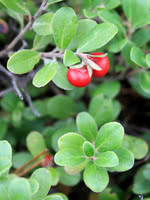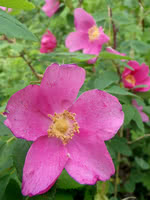Mon-Fri 9am - 5pm Mountain time
Bearberry vs Hedge Rose
Arctostaphylos uva-ursi
Rosa rugosa x Rosa woodsii (Improved hybrid developed by PFRA)
NOT AVAILABLE THIS SEASON - MIGHT RETURN
Bearberry is a dwarf shrub known for its creamy pink flowers and red edible fruits.
It is great as a filler in gardens and flowerbeds in place of invasive ground cover plants, like English Ivy.
Bearberry will attract hummingbirds, butterflies and bees to your property. It is one of the top 12 plants recommended by the Alberta Native Bee Council to support pollinators.
Hedge Rose is a long-lived, fast-growing shrub. It bears similar flowers to the Alberta Wild Rose. Birds will love its deep red rose hips. Hedge Rose will thrive in a wide variety of soils and is a tall rose forming a useful hedge.
Excellent for shelterbelts, ecobuffers, and wildlife habitat plantings. Continuous flowering makes it attractive to pollinators. Many song and game birds utilize this tree for food and habitat.
In use since the early 1900s, this hybrid was originally developed at the PFRA's Indian Head Agroforestry Center.
Bearberry Quick Facts
Hedge Rose Quick Facts
In row spacing: 0.3 m (1.0 ft)

